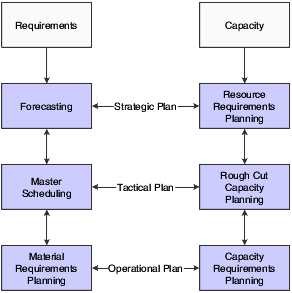Understanding Capacity Planning
Use Capacity Planning to ensure that sufficient capacity is available to accomplish the planned production schedule that is generated by Master Production Schedule (MPS) or Material Requirements Planning (MRP). If sufficient capacity is not available, then you must alter the plan or the capacity.
JD Edwards EnterpriseOne Capacity Planning from Oracle comprises:
Resource Requirements Planning (RRP).
Rough Cut Capacity Planning (RCCP).
Capacity Requirements Planning (CRP).
This flowchart illustrates the planning system process:

RCCP identifies capacity constraints at critical work centers.
CRP matches the available personnel and equipment resources to the resource requirements as generated by MRP. CRP indicates whether you need to revise the material requirements plan or increase resources.
Work center capacity is based on available hours to produce products within certain time frames. MPS, MRP, and JD Edwards EnterpriseOne Shop Floor Management provide the actual hours to produce products based on the quantity that is required.
Manufacturing must determine whether the production plan is supportable as is or whether additional future resources are needed, such as:
Additional skilled labor.
New machinery.
New facilities or additional real estate.
Demand forecasting is the logical starting point for developing a resource requirements plan. However, you must remember that the demand forecast is not the actual plan, but that it is used as input for the plan. RRP provides an estimate of the time and resources that you need to produce a product.
You generate a resource requirements plan after you generate the long-term forecast but before you run the Master Scheduling program. RRP uses the data from a forecast of future sales to estimate the time and resources that are required to meet the production plan.
RRP can help you resolve long-range planning issues such as:
Expanding existing facilities.
Acquiring new facilities.
Staffing loads.
Determining capital expenditures for equipment.
RRP enables you to support the company's strategic business plan with a realistic tactical plan that:
Is shorter in range than the strategic plan and has a planning horizon of 12 months to three years.
Enables planning at the product family level and has greater detail than the strategic plan.
Validates the monetary amounts that are allotted to the business plan.
The Resource Requirements Planning program (P3380) generates a capacity plan by critical work center. To answer long-range planning questions, you need to know the current capacity and the requirements to support the planned workload.